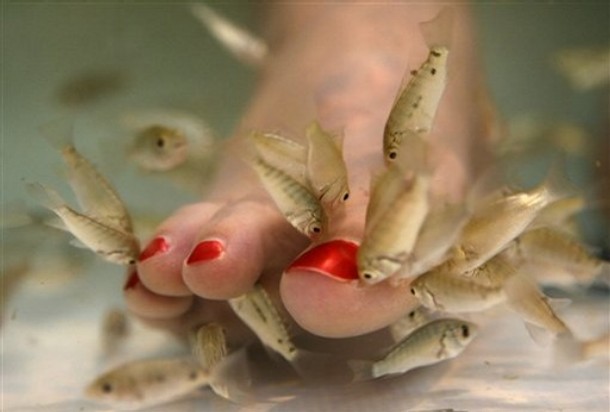In 2008, a new craze swept the nail industry as women (and men) put their feet into water containing fish that ate the dead skin off feet.
Washington State, and others, said no way, and would not approve the process.
Now there’s some data to back up the ban.
On Wednesday, the U.S. Centers for Disease Control published a report by the Centre for Environment, Fisheries & Aquaculture Science in the United Kingdom, which studied the kinds  of bacteria carried by the Garra rufa, or "doctor fish," an 2.5-cm-long silver carp native to Southeast Asia.
of bacteria carried by the Garra rufa, or "doctor fish," an 2.5-cm-long silver carp native to Southeast Asia.
"To date there has been only limited information on the types of bacteria associated with these fish," lead researcher David Verner-Jeffreys said. "Our study identified some of the species of bacteria associated with this fish species, including some that can cause infections in both fish and humans."
It’s no secret that water provides a fertile breeding ground for all kinds of bacteria. Mix the bacteria living on fish scales or in their waste with even the tiniest cut from an overzealous doctor fish, and the risk of infection is very real.
Doctor fish generally are imported to salons from Indonesia or Malaysia, which can make it difficult to control the quality of the fish breeding and environment.
After an outbreak of strep bacteria last year in a shipment of the fish, the British government seized five containers from London’s Heathrow Air-port and found they carried some species of bacteria that can cause disease in humans and fish.
These bacteria included: Aeromonas, which causes wound infections and gastrointestinal problems in humans; Streptococcus agalactiae, which causes skin and soft tissue infections; and Mycobacteria, which the study reported have been responsible for skin infections in some pedicure clients in the U.K.
"To date, there are only a limited number of reports of patients who might have been infected by this expo-sure route," the report says. "However, our study raises some concerns over the extent that these fish, or their transport water, might harbor … pathogens of clinical relevance."
"It should be emphasized that neither us nor the [British] Health Protection Agency are advising that the practice should be banned," Verner-Jeffreys said.

.jpg) Christine Anthony, spokeswoman for the department, said it’s impossible to sanitize the live fish.
Christine Anthony, spokeswoman for the department, said it’s impossible to sanitize the live fish.  Local health inspectors may have a new task to add to their burgeoning workload: inspecting salons that offer pedicures in tanks filled with toothless fish that nibble away at dead skin.
Local health inspectors may have a new task to add to their burgeoning workload: inspecting salons that offer pedicures in tanks filled with toothless fish that nibble away at dead skin.